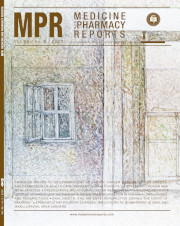Prevalence of anxiety and depression of health care workers during COVID-19 – a systematic review and meta-analysis
DOI:
https://doi.org/10.15386/mpr-2579Keywords:
depression, anxiety, burn-out, emotional distress, fear, health care workers, nurses, resident, doctor, physician, coronavirus, COVID-19, SARS-COV-2Abstract
Introduction. During the COVID-19 pandemic, the workload of healthcare workers managing the disease, increased significantly. The objective of this review is to determine the anxiety and depression prevalence among healthcare workers during the pandemic period.
Methods. We searched systematically the literature in five electronic databases such as PubMed, CINAHL, ScienceDirect, MEDLINE, and Cochrane COVID-19 study register. The last online research was performed in May 2022. We included only cross-sectional studies and performed a meta-analysis of pooled prevalence. Publication bias was assessed with a funnel plot and Egger’s and Begg’s tests. A random effect was applied and heterogenicity I2 was calculated. Quality assessment of included studies was performed using the Joanna Briggs Institute tool.
Results. In this review, we included 14 cross-sectional studies comprising 7780 healthcare workers. Participants were from the whole spectrum of healthcare workers. The pooled prevalence of depression was 33.8% (95% CI: 24.6 – 43.6), heterogenicity I2: 98.69% . The pooled prevalence of anxiety was 41.3% (95% CI: 30.2 – 52.9), heterogenicity I2: 99.01%.
Conclusion. One-third of healthcare workers suffered from depression, and more than one-third suffered from anxiety during the COVID-19 pandemic. Increased measures of surveillance of mental health should have been taken, as well as the support of healthcare workers running a high risk of psychological distress during the COVID-19 pandemic.
Downloads
Published
How to Cite
Issue
Section
License
The authors are required to transfer the copyright of the published paper to the journal. This is done by agreeing to sign the Copyright Assignment Form. Whenever the case, authors are also required to send permissions to reproduce material (such as illustrations) from the copyright holder.

The papers published in the journal are licensed under a Creative Commons Attribution-NonCommercial-NoDerivatives 4.0 International License.

